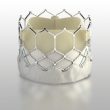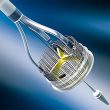1) New Study Confirms TAVR Durability at 5 Years The ADVANCE study was designed to evaluate the safety and effectiveness of transcatheter aortic valve replacement (TAVR) with self-expanding prosthesis CoreValve in “real world” patients with symptomatic, severe aortic stenosis at high surgical risk. Read the conclusions of this study 2) An Important Study Shows That Renal Function Must Be Cared for in<a href="https://solaci.org/en/2017/11/15/here-you-will-find-the-last-news-about-tavr/" title="Read more" >...</a>
The SOURCE 3 Confirms the Good Outcomes of the SAPIEN 3 at One Year Followup
Transcatheter aortic valve replacement (TAVR) was developed as a strategy to treat non-surgical aortic stenosis, and was later expanded to elderly patients at intermediate risk, because of increased operator experience (overcoming the learning curve) and improved devices. The present study presents the one year outcomes of the SOURCE 3 trial, the multicenter European registry of the<a href="https://solaci.org/en/2017/10/27/the-source-3-confirms-the-good-outcomes-of-the-sapien-3-at-one-year-followup/" title="Read more" >...</a>
New Study Confirms TAVR Durability at 5 Years
The ADVANCE study was designed to evaluate the safety and effectiveness of transcatheter aortic valve replacement (TAVR) with self-expanding prosthesis CoreValve in “real world” patients with symptomatic, severe aortic stenosis at high surgical risk. Patients were enrolled from 44 experimental centers in 12 countries; treatment approach and choice of anaesthesia were determined by the local Heart Team.<a href="https://solaci.org/en/2017/10/25/new-study-confirms-tavr-durability-at-5-years/" title="Read more" >...</a>
An Important Study Shows That Renal Function Must Be Cared for in TAVR
Courtesy of Dr. Carlos Fava. The presence of renal dysfunction in the “real world” is over 25% in patients who undergo transcatheter aortic valve implantation (TAVI). The evolution of this disease among patients who are subjected to a replacement is well known, but evidence for patients who undergo TAVI is still limited, particularly for those who<a href="https://solaci.org/en/2017/10/20/an-important-study-shows-that-renal-function-must-be-cared-for-in-tavr/" title="Read more" >...</a>
REPRISE III: Need for Pacemaker and Paravalvular Leak with Lotus
A recent presentation at London Valves took a closer look at the REPRISE III trial as regards two points that generated much discussion, such as need for a pacemaker and paravalvular leak. REPRISE III had previously demonstrated that the Lotus is noninferior to first-generation CoreValve and Evolut R in terms of safety. Additionally, it proved to be superior<a href="https://solaci.org/en/2017/10/18/reprise-iii-need-for-pacemaker-and-paravalvular-leak-with-lotus/" title="Read more" >...</a>
End of Discussion on the Impact of Pacemaker After TAVR?
Transcatheter aortic valve replacement (TAVR) is often associated with conduction abnormalities, which usually end with permanent pacemaker (PPM) implantation in 10-40% of patients. Factors predisposing to PPM after TAVR have been studied in great detail, but their short- and long-term clinical impact is still controversial. Recently, outcomes from a large cohort of patients were<a href="https://solaci.org/en/2017/10/10/end-of-discussion-on-the-impact-of-pacemaker-after-tavr/" title="Read more" >...</a>
It Is a Fact: Cerebral Protection in TAVR Has Proved to Reduce Stroke and Death
Cerebral ischemic events after transcatheter aortic valve replacement (TAVR) have been identified as independent predictors of morbidity and mortality. New-generation devices have managed to partially reduce the rate of cerebral events, but it still is around 5.5% at 30 days for patients undergoing TAVR through transfemoral access. First data on cerebral protection devices had only shown<a href="https://solaci.org/en/2017/09/29/it-is-a-fact-cerebral-protection-in-tavr-has-proved-to-reduce-stroke-and-death/" title="Read more" >...</a>
Conscious Sedation in TAVR: Is It Advisable?
The fundamental advantage offered by transcatheter aortic valve replacement (TAVR) has always been the fact that it is less invasive than surgical valve replacement. So far, most improvements for these devices have derived in less invasiveness (e.g., by improving the profile of the eluting system). However, there are also cases of “deployment” reduction during the<a href="https://solaci.org/en/2017/09/25/conscious-sedation-in-tavr-is-it-advisable/" title="Read more" >...</a>
A Simple Electrocardiography to Predict Mortality in TAVR
Conduction abnormalities, such as new left bundle branch block, atrioventricular block, and need for a pacemaker, are still among the most frequent complications in transcatheter aortic valve replacement (TAVR). New valve generations have (mostly) not managed to reduce significantly electrical abnormalities; furthermore, some modifications such as external skirts, which are extremely effective for the reduction<a href="https://solaci.org/en/2017/08/29/a-simple-electrocardiography-to-predict-mortality-in-tavr/" title="Read more" >...</a>
Post TAVR Dialysis: a Severe Complication Less and Less Frequent
The prevalence of pre-procedural kidney failure in patients undergoing transcatheter aortic valve replacement (TAVR) can be as high as 50 – 60% (stage 3 kidney failure or worse); it has been strongly associated with acute kidney deterioration and, ultimately, an increase of post TAVR mortality. A recent meta-analyzis of several small studies carried out in a single<a href="https://solaci.org/en/2017/08/25/post-tavr-dialysis-a-severe-complication-less-and-less-frequent/" title="Read more" >...</a>









